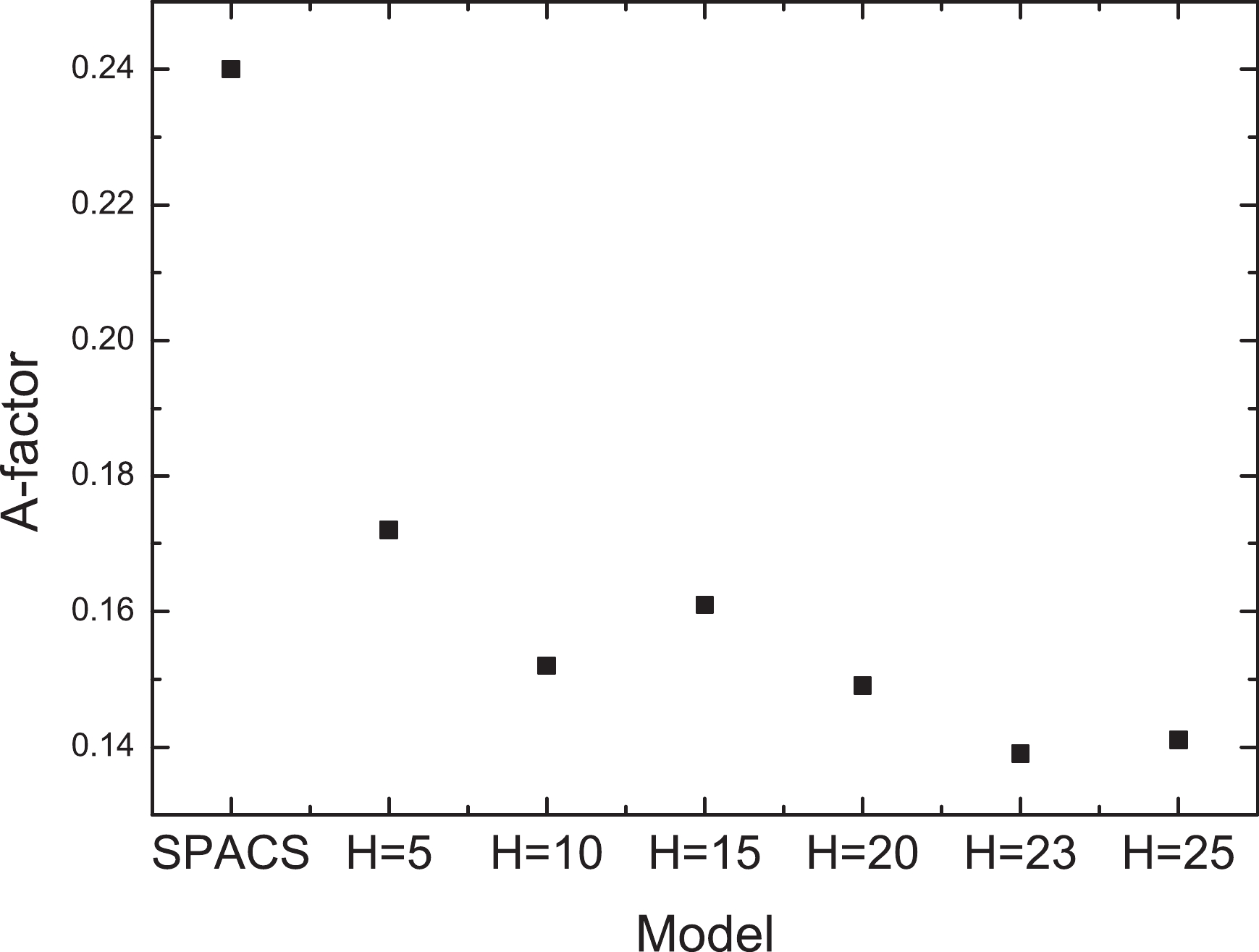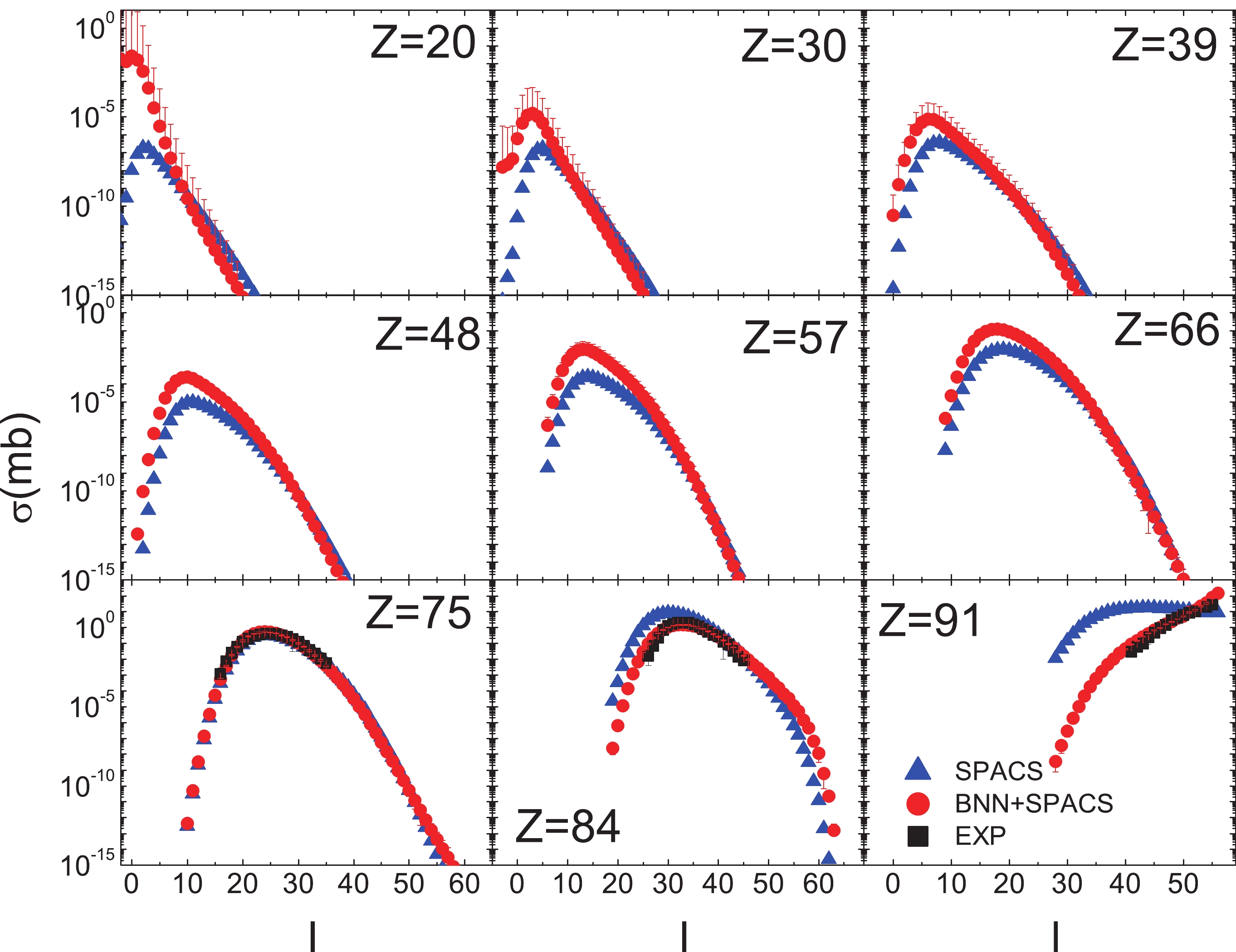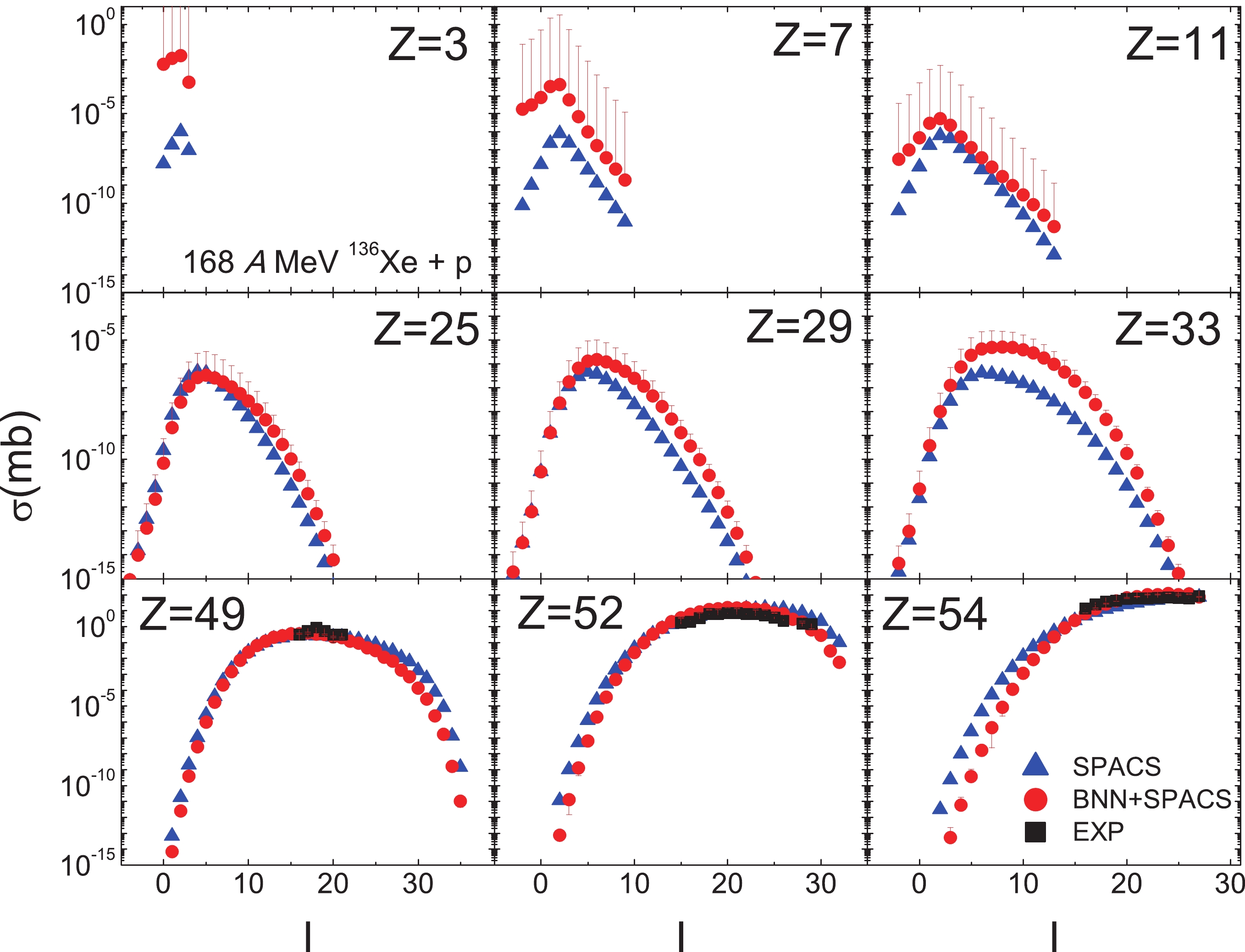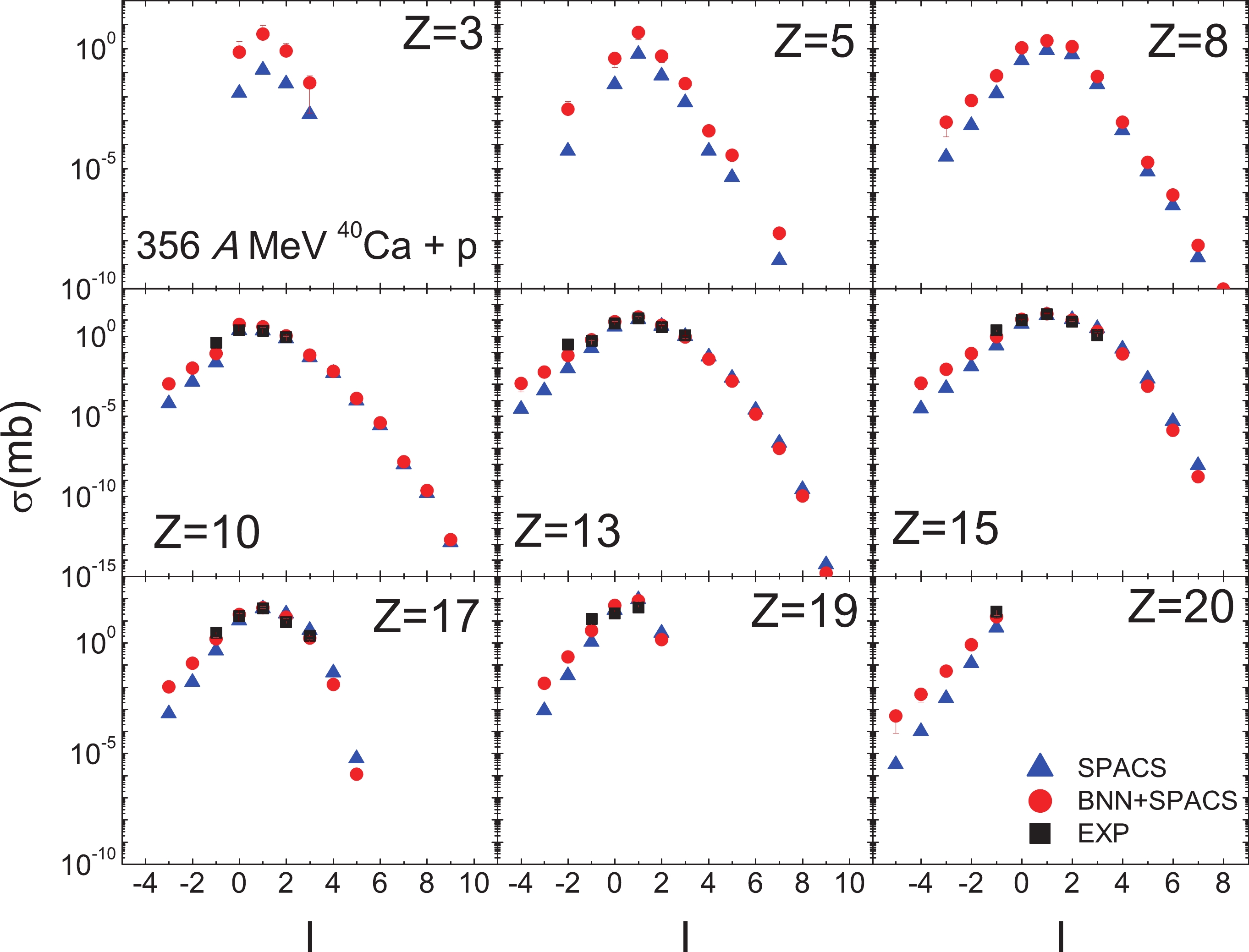HTML
--> --> -->Its extensive applications have attracted both experimental and theoretical interests. In early times, the experiments were usually carried out using accelerated protons on the synchrocyclotron or using cosmic rays. After the reverse kinetic technique was proposed, massive experiments have been performed to measure the spallation fragments above 56Fe, covering the incident energy range of a few hundreds of A MeV to higher than A GeV. Prodigious data for fragments in spallation reactions have been assembled.
On the theoretical front, many models have been developed. The quantum molecular dynamics model has been improved for spallation reactions [9-11]. The statistical multi-fragmentation model [12-14] and the Liège intranuclear cascade (INCL++) model [15-17] (which has been implanted in the OpenMC, GEANT4, and FLUKA toolkits [18, 19]) can be used to simulate spallation reactions, which are usually followed by a secondary decaying simulation to reproduce the experimental results (a review is also recommended [20]). Some semi-empirical parameterizations, including the EPAX [21] and the SPACS [22], can globally predict the residue fragments in the spallation reaction. The nuclear energy agency (NEA) systematically compared the international codes and models for the intermediate energy activation yields to meet the needs of ADS designation, energy amplification, and medical therapy [23]. Difficulties still exist, as the spallation reaction involves a wide incident energy range, as well as a wide range of nuclei, from light to heavy ones. Since the important applications of spallation reactions and the resultant residues productions, it is important to improve the theoretical predictions for the proton induced spallation reactions. The existing models are limited with regard to predicting the light fragments, particularly for proton-induced reactions at low energy. It is necessary to propose a new method for the accurate prediction of the fragments in spallation reactions.
The neural network method, one of the machine learning technologies, is being increasingly employed in nuclear physics. In the standard neural network, it is difficult or even impossible to control the complexity of the model, which is likely to lead to overfitting and reduce the generalization ability of the network [24]. The Bayesian neural network (BNN) provides a good means for avoiding overfitting automatically by defining vague priors for the hyperparameters that determine the model complexity [25]. A prior distribution of the model parameters can be incorporated in Bayesian inference and combined with training data to control the complexity of different parts of the model [26]. Successful examples of BNN applications in nuclear physics can be found in the predictions of nuclear mass [27-29], nuclear charge radii [30], nuclear
In this article, a new method is proposed to predict the fragment cross sections in proton-induced spallation reactions. The BNN method is described in Sec. 2. The results and discussions are presented in Sec. 3, and a conclusion is given in Sec. 4.
$ \begin{array}{l} p(\theta|D) = p(D|\theta)p(\theta)/p(D)\propto L(\theta)p(\theta), \end{array} $  | (1) |
The introduction of the prior distribution is a crucial step that allows the prediction to go from a likelihood function to a probability distribution. The normalized quantity
$ \begin{array}{l} p(D) = \displaystyle\int_{\theta}p(D|\theta)p(\theta){\rm d}{\theta}. \end{array} $  | (2) |
$ \begin{split}& p(D|\theta) = {\rm exp}(-\chi^{2}/2), \ \ \chi^{2} = \sum\limits_{i}^{N} [y_{i}-f(x_{i};\theta)]^2 / \Delta{y_{i}^2}, \end{split} $  |
$ \begin{array}{l} f(x;\theta) = a+\displaystyle\sum\limits_{j = 1}^{H}b_j\, {\rm tanh}\left(c_j+\displaystyle\sum\limits_{i = 1}^{I} d_{ji} x_i\right), \end{array} $  | (3) |
Based on the theoretical principles and prior knowledge, the posterior distribution can be obtained from the data using Eq. (1). The predictive distribution of output
$ \begin{array}{l} p(y^{\rm new}|x^{\rm new},D) = \displaystyle\int p(y^{\rm new}|x^{\rm new},\theta) p(\theta){\rm d}\theta. \end{array} $  | (4) |
$ \begin{array}{l} y^{\rm new} = E[y^{\rm new}|x^{\rm new},D] = \displaystyle\int f(x^{\rm new},\theta) p(\theta|D){\rm d}\theta. \end{array} $  | (5) |
$ \begin{array}{l} y^{\rm new} = 1/K\displaystyle\sum\limits^{K}_{k = 1}f(x^{\rm new},\theta^{t}), \end{array} $  | (6) |
$ \begin{array}{l} y_{i} = \rm{lg}(\sigma^{\rm exp})-\rm{lg}(\sigma^{\rm th}). \end{array} $  | (7) |
$ \begin{array}{l} \sigma^{\rm BNN+th} = \sigma^{\rm th}\times10^{y^{\rm new}}, \end{array} $  | (8) |
The inputs of the neural network are the mass numbers
  | E/(MeV/u) | numbers |   | Ref. |
| 36Ar + p | 361 | 42 | 9-17 | [35] |
| 546 | 42 | 9-17 | ||
| 765 | 38 | 9-17 | ||
| 40Ar + p | 352 | 45 | 9-17 | [35] |
| 40Ca + p | 356 | 48 | 10-20 | [36] |
| 565 | 54 | 10-20 | ||
| 763 | 54 | 10-20 | ||
| 56Fe + p | 300 | 128 | 10-27 | [37] |
| 500 | 136 | 10-27 | ||
| 750 | 148 | 8-27 | ||
| 1000 | 152 | 8-26 | ||
| 1500 | 157 | 8-27 | ||
| 136Xe + p | 168 | 73 | 48-55 | [38] |
| 200 | 96 | 48-55 | [39] | |
| 500 | 271 | 41-56 | [40] | |
| 1000 | 604 | 3-56 | [41] | |
| 197Au + p | 800 | 352 | 60-80 | [42] |
| 208Pb + p | 500 | 249 | 69-83 | [43] |
| 1000 | 458 | 61-82 | [44] | |
| 238U + p | 1000 | 364 | 74-92 | [45] |
Table1.A list of the adopted data for the measured fragments in the X + p spallation reactions.
 Figure1. A-factor for the predictions by the SPACS and the BNN + SPACS model with different numbers of hidden neurons, denoted by H, for the validation set.
Figure1. A-factor for the predictions by the SPACS and the BNN + SPACS model with different numbers of hidden neurons, denoted by H, for the validation set. $ \begin{array}{l} A_f = 1/N\displaystyle\sum\limits^{N}_{i = 1}\frac{|\sigma^{\rm exp} - \sigma^{\rm pre}|}{\sigma^{\rm exp} + \sigma^{\rm pre}}, \end{array} $  | (9) |
In Fig. 1, the A-factors for the SPACS predictions and BNN method with different numbers of hidden neurons are compared. It is observed that even the BNN with five hidden neurons can significantly improve the predictions. The A-factor decreased with an increase in H. When H increased to 23, the A-factor could not be minimized further. A 5-23-1 structure is taken as the optimal network structure, which means that 5 inputs
The BNN + SPACS predictions for fragment cross sections in the 1 A GeV 136Xe + p, 168 A MeV 136Xe + p, 356 A MeV 40Ca + p, and 1 A GeV 238U + p reactions are shown in Fig. 2 to Fig. 5, and compared with the experimental data as well as the SPACS predictions.
 Figure2. (color online) BNN + SPACS predictions of fragment cross sections of 1000 A MeV 136Xe + p compared with SPACS and experimental data (taken from [41]). In the x axis, I = N - Z denotes the fragment neutron excess. The measured data, BNN + SPACS predictions, and SPACS predictions are plotted as squares, circles, and triangles, respectively. The experimental and BNN + SPACS error bars are too small to be shown.
Figure2. (color online) BNN + SPACS predictions of fragment cross sections of 1000 A MeV 136Xe + p compared with SPACS and experimental data (taken from [41]). In the x axis, I = N - Z denotes the fragment neutron excess. The measured data, BNN + SPACS predictions, and SPACS predictions are plotted as squares, circles, and triangles, respectively. The experimental and BNN + SPACS error bars are too small to be shown. Figure5. (color online) Same as Fig. 2 but for the 1 A GeV 238U + p reaction (experimental data taken from Ref. [45]).
Figure5. (color online) Same as Fig. 2 but for the 1 A GeV 238U + p reaction (experimental data taken from Ref. [45]).In Fig. 2, the predicted and measured fragment cross sections in the 1 A GeV 136Xe + p reaction are compared. It is observed that the BNN + SPACS predictions agree quite well with the measured data for fragments from
Figure 3 shows the BNN + SPACS predictions for fragment cross sections in the 168 A MeV 136Xe + p reaction, which have been measured at RIBF, RIKEN recently [38]. In [38], only the cross sections for
 Figure3. (color online) Same as Fig. 2 but for the 168 A MeV 136Xe + p reaction (experimental data taken from Ref. [38]).
Figure3. (color online) Same as Fig. 2 but for the 168 A MeV 136Xe + p reaction (experimental data taken from Ref. [38]).The spallation of intermediate nuclei is of interest in proton therapy and nuclear astrophysics. The composition of interstellar matter is influenced by cosmic ray (mainly high-energy proton)-induced spallation reactions. The 40Ca + p reaction at 356 A MeV, for which the predicted and measured results are shown in Fig. 4, has been studied. Compared to the measured results, both the BNN + SPACS and SPACS predictions could reproduce the experimental data quite well. The fragment cross sections predicted by the BNN + SPACS method are in line with those predicted by SPACS except for the
 Figure4. (color online) Same as Fig. 2 but for the 356 A MeV 40Ca + p reaction (experimental data taken from Ref. [36]).
Figure4. (color online) Same as Fig. 2 but for the 356 A MeV 40Ca + p reaction (experimental data taken from Ref. [36]).The predictions for the fragment cross sections in the 1 A GeV 238U + p reaction are compared in Fig. 5. The measured data cover the fragments from
The BNN + SPACS predictions are further verified by using the correlation between the cross section and the average binding energy, which has been elucidated in Ref. [33]. It is generally believed that the isotopic cross section depends on the average binding energy in the form of
 Figure6. (color online) Isotopic cross section dependence on average binding energy for fragments of Z = 17 and 41 produced in the 1 A GeV 136Xe + p reaction (experimental data taken from [41]). The open circles, solid circles, triangles, and squares denote the data corresponding to the BNN predictions (see Ref. [33]), BNN + SPACS in this work, SPACS, and the measured data, respectively. The solid line denotes the fitting to the experimental data (see text for further explanation).
Figure6. (color online) Isotopic cross section dependence on average binding energy for fragments of Z = 17 and 41 produced in the 1 A GeV 136Xe + p reaction (experimental data taken from [41]). The open circles, solid circles, triangles, and squares denote the data corresponding to the BNN predictions (see Ref. [33]), BNN + SPACS in this work, SPACS, and the measured data, respectively. The solid line denotes the fitting to the experimental data (see text for further explanation).From the above results, which cover the fragment cross section predictions for proton-induced reactions ranging from intermediate to heavy nuclei and for the incident energy range of 168 A MeV to 1 A GeV, it is observed that the BNN approach improves the quality of the empirical SPACS parameterizations through the reconstruction of the residual cross sections between the SPACS predictions and measured data. Thus, the BNN + SPACS method can be a new tool to predict the fragment cross section in spallation reactions since it can work independently after the network is formed.
If we revisit the foundation of the BNN approach, it is natural that the BNN + SPACS model should provide a better prediction than the SPACS parameterizations since the difference between the SPACS and measured data has been minimized. Therefore, the BNN + SPACS model makes improved predictions and also avoids the nonphysical phenomenon by forming a direct BNN learning network from the measured data, as shown in Ref. [33]. The physical implantations of SPACS play important roles to make the BNN + SPACS method reasonable in physics, and the learning and predicting abilities of the BNN also improve the predictions where the SPACS parameterizations do not perform well.
The results indicate that the SPACS tends to underestimate the cross sections for fragments with relatively small Z, whereas it overestimates the cross sections for fragments with Z close to those for heavy spallation nuclei. These shortcomings have been overcome by the BNN + SPACS model. Limitations still exist for the BNN + SPACS model constructed in this work due to the absence of experimental data for reactions of incident energy below 100 A MeV and for small spallation systems. For applications in proton therapy, the incident energy can be lower than 100 A MeV, and the masses of the spallation nuclei are smaller than 30. The smallest spallation reaction adopted in this work is for 36Ar. If we consider interstellar matter, most of the nuclei have mass numbers smaller than 56. Regarding the spallation reactions induced by high-energy cosmic rays and the proton therapy process, we should improve the prediction model to account for small spallation systems, for which the SPACS parameterizations do not work well. It is important to improve the BNN + SPACS predictions by introducing new data for spallation reactions of intermediate energy (for example, below 100 A MeV) and intermediate/small systems (
